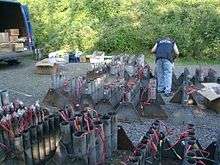Mascletà

A mascletá (pronounced in Valencian /maskle'ta/ and, popularly written as mascletà and normatively mascletada) is a pyrotechnic event characterized by the achievement of a noisy and rhythmic composition that features, particularly during daytime, in street festivities; it is typical of the Valencian Community (Spain). It gets its name from the masclets (very loud firecrackers) that are tied by a wick to form a line or firework display. These are usually fastened at a medium height with ropes or raised by cannons.
Unlike the fireworks that seek visual stimulation, the mascletades (pronounced in Valencian /maskle'taes/ and written in an informal way as mascletaes) aim to stimulate the body through strong rhythmic sounds of masclets; some people consider these sounds as "musical" sounds, while not neglecting the importance of the visual aspect. What distinguishes a mascletà from a succession of explosions is the rhythm that masclets must create to explode. It is essential that the force of the explosions must gradually rise, before coming to a dramatic conclusion; because without that, a mascletà can’t be considered as such.
Places in Spain where mascletás are let off
The mascletàs are famous throughout all the Community of Valencia but those especially well-known are from March 1 to 19 at 2:00 pm in the Plaza del Ayuntamiento of Valencia and from March 3 to 19 at 2:00 pm in the Plaza del Reino of Alcira, both during the Fallas festivities. There are also mascletàs during the festivities of the Magdalena in Castellón and in Alicante from June 19 to 24 in the Plaza de los Luceros during the festivities of the Bonfires of Saint John. For some years, the mascletàs have also been introduced during the August festivities in Elche and they are let off in the Paseo de la Estación, where you can appreciate the beautiful image of the Palmeral of Elche.
History
Initially the mascletà was let off in the Plaza del Ayuntamiento of Valencia on March 19 (Saint Joseph's Day) as the culmination of the festivities. Afterwards, the number of mascletàs was extended up to the current 19 (from 1 March to 19). The mascletà of Valencia has continuous evolved, especially in technique and in the amount of powder used. For security reasons the amount of gunpowder has been limited to 120 kilos per mascletà. The only exception has been on the 19 March 2008, when the limit went up to 240 kilos. The technique has evolved and nowadays electronic programmes are used to ignite the explosions. This allows more accuracy and increases safety.Traditionally, pyrotechnicians would ignite the mascletà with a wick.
Parts

A mascletá usually consists of four parts:
- Start: The show begins with both sound and visual effects.
- Body: During the central part of the mascletà the intensity and volume goes up.
- Terratrèmol (earthquake): The stronger fireworks, called masclets, burst in unison.
- Air show: Intense aerial fireworks. They are always visible for spectators and are accompanied by colours.
Innovations have been introduced in these four parts, and they have made mascletades more complex than a "traditional" structure. The use of electronic controllers allows complexity and a combination of both air and ground pyrotechnics.
External links
| Wikimedia Commons has media related to Mascletades. |
- Explanation of a mascletà in DistritoFallas.com
- Ars Sonora in the Valencia mascletá The mascletá as a sound art, in the programme Ars Sonora, by Miguel Álvarez-Fernández, in Radio Clásica.
- Videos of Valencia mascletades 2008
- Page on pyrotechnics section on mascletadas Valencia
